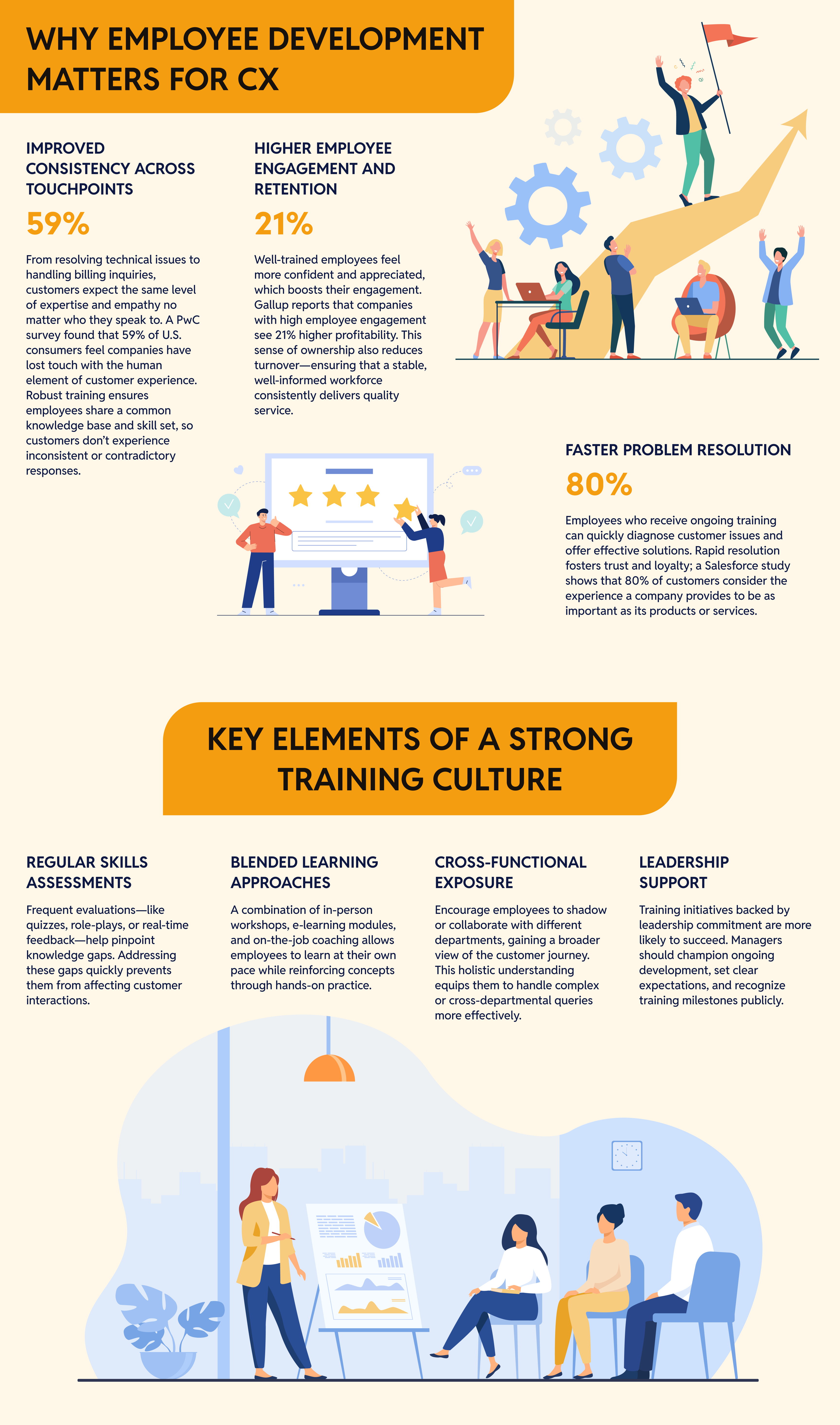Imagine a customer reaching out to your support line, uncertain if they’ll speak with someone empathetic and knowledgeable. Now imagine every customer interaction—whether by phone, chat, or in person—reflecting the same high standard of service. This consistency doesn’t happen by accident; it’s the product of well-structured employee development programs. According to Deloitte, companies that invest in employee training report a 37% higher productivity rate¹. In an age where customer experience (CX) is a significant competitive differentiator, consistent training translates directly into consistent, memorable customer service.
In this article, we’ll explore the link between employee development and customer satisfaction, provide actionable tips for creating a training culture, and highlight how XMC360 helps organizations embed a holistic training strategy that shapes exceptional customer experiences.


Why Employee Development Matters for CX

Improved Consistency Across Touchpoints
From resolving technical issues to handling billing inquiries, customers expect the same level of expertise and empathy no matter who they speak to. A PwC survey found that 59% of U.S. consumers feel companies have lost touch with the human element of customer experience². Robust training ensures employees share a common knowledge base and skill set, so customers don’t experience inconsistent or contradictory responses.

Higher Employee Engagement and Retention
Well-trained employees feel more confident and appreciated, which boosts their engagement. Gallup reports that companies with high employee engagement see 21% higher profitability³. This sense of ownership also reduces turnover—ensuring that a stable, well-informed workforce consistently delivers quality service.

Faster Problem Resolution
Employees who receive ongoing training can quickly diagnose customer issues and offer effective solutions. Rapid resolution fosters trust and loyalty; a Salesforce study shows that 80% of customers consider the experience a company provides to be as important as its products or services⁴.
Key Elements of a Strong Training Culture

Regular Skills Assessments
Frequent evaluations—like quizzes, role-plays, or real-time feedback—help pinpoint knowledge gaps. Addressing these gaps quickly prevents them from affecting customer interactions.

Blended Learning Approaches
A combination of in-person workshops, e-learning modules, and on-the-job coaching allows employees to learn at their own pace while reinforcing concepts through hands-on practice.

Cross-Functional Exposure
Encourage employees to shadow or collaborate with different departments, gaining a broader view of the customer journey. This holistic understanding equips them to handle complex or cross-departmental queries more effectively.

Leadership Support
Training initiatives backed by leadership commitment are more likely to succeed. Managers should champion ongoing development, set clear expectations, and recognize training milestones publicly.
The Impact on Customer Experience
A workforce that’s consistently trained and up-to-date in best practices leads to customers who feel heard, supported, and confident in your brand. As a result:
- Higher Customer Satisfaction: Consistent, personalized experiences reduce frustration.
- Increased Loyalty and Advocacy: Satisfied customers are more inclined to become repeat buyers and recommend your brand to others.
- Positive Brand Reputation: When training is woven into company culture, it translates into service that’s empathetic, informed, and solution-oriented—attributes that shape a strong reputation in the market.
A LinkedIn Learning survey discovered that 94% of employees would stay at a company longer if it invested in their career development⁵. The synergy between engaged employees and happy customers cannot be overstated.
How XMC360 Empowers Consistent Training and Service
At XMC360, we believe that employee development is the foundation of an outstanding customer experience. Our platform offers:
Centralized Knowledge Base
Ensure every representative references the same up-to-date documentation, FAQs, and how-to guides. This eliminates guesswork and maintains consistent service quality.
Real-Time Performance Analytics
Track individual and team metrics like first-contact resolution rate, average handling time, and CSAT scores. Identify training needs promptly and act before customer service suffers.
Integrated Training Modules
Offer microlearning, video tutorials, and interactive quizzes directly within the platform. Employees can brush up on skills without leaving their workflow, making training both accessible and continuous.
Cross-Channel Sync
Seamlessly align training content across phone, chat, email, and social media channels, ensuring employees provide the same level of expertise wherever customers engage.

Consistent training is the cornerstone of a consistently excellent customer experience. From boosting employee engagement to delivering swift, accurate support across all channels, robust training programs ensure every touchpoint reflects your brand’s commitment to quality.
At XMC360, we enable companies to seamlessly integrate training with ongoing operations, guaranteeing that each customer interaction—no matter how big or small—meets the mark. Ready to elevate your customer experience through employee development? Contact XMC360 and see how our platform aligns training initiatives with real-time performance metrics, empowering teams to thrive and customers to stay loyal.
References:
- Deloitte. (2021). Workforce Development & Productivity Trends.
- PwC. (2018). Experience is everything: Here’s how to get it right.
- Gallup. (2020). State of the Global Workplace.
- Salesforce. (2019). State of the Connected Customer.
- LinkedIn Learning. (2019). Workplace Learning Report.


